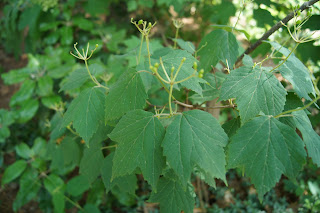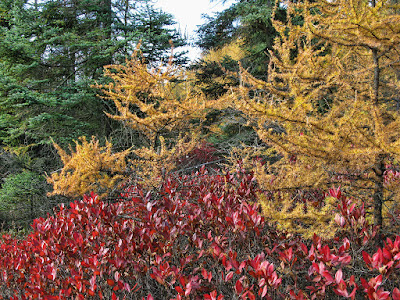 |
| Joanne's garden illustrates how to use native plants beautifully |
Joanne moved into the house in 1990 and set out to create a garden on the quarter-acre lot. In the sunny front yard, she replaced much of the lawn with four planting beds. A drought-tolerant pollinator garden beside the foundation provides a lesson in how to combine native perennials and shrubs attractively.
 |
| The drought-tolerant pollinator bed combines native and nonnative perennials and shrubs |
I was particularly interested to see two chokeberries (Aronia arbutifolia ‘Brilliantissima’) that by fall will be covered with red fruits for birds to eat.
 |
| Chokeberries |
I see that I’ll need to move the chokeberry I planted to a sunnier spot.
Heading through a gate and along the side of the house, I spotted an unfamiliar shrub with large shiny leaves and flat-topped flower clusters about to open.
 |
| Possumhaw viburnum |
This was possumhaw viburnum (Viburnum nudum ‘Winterthur’), and it was romantically draped with two kinds of native clematis vines.
 |
| These clematis flowers will turn from green to white |
Like the chokeberries, the viburnum provides fruit for wildlife. The berries start out pink and turn blue, Joanne explained.
The backyard was unexpectedly different from the front. As you enter, there’s a midsummer meadow garden of mostly native plants.
 |
| The meadow garden |
In a nearby spring and late summer bed, we spotted a robin foraging for fruit in a serviceberry tree (Amelanchier lamarckii).
 |
| Serviceberry fruit |
Opposite the back of the house, Joanne had set two levels of terraced planting beds into a steeply pitched hillside, with stone steps curving up the slope beside them.
 |
| Terraced beds make planting space on the hillside |
Above is a woodland garden, where I recognized some plants I grow in my own shady lot. At every turn there were beautiful specimens of native understory trees, shrubs, and shade perennials, some I’d only read about.
 |
| Mapleleaf viburnum in the woodland garden |
Joanne’s gardening techniques are inspiring too. She uses no chemicals and has no irrigation system. She fills her watering can from four water barrels for spot watering and to establish new plants.
 |
| Water barrels supplement rain |
She only wants plants that are tough enough to thrive without supplemental watering, and clearly she’s chosen the right ones. She improves soil with compost and shredded leaf mulch. I was glad to know that in addition to straight native species, she grows (neonic-free) cultivars, and she finds that they attract plenty of insects and other wildlife. She blends natives with some nonnatives in a harmonious whole.
Birds were everywhere in the garden. Joanne cuts back on filling birdfeeders in midsummer to encourage birds to eat insects. She kept two snags (dead trees) standing for the birds and insects.
What a boost to my gardening motivation it was to see this lovely garden! You can do great things with native plants if, like Joanne, you have knowledge and an artist’s eye.
























